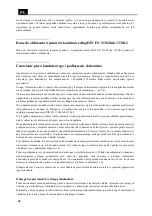
EN
34
operating instructions. Please take note of the safety notes detailed in Chapter
►
General notes, safety notes – p. 35.
Permitted fuels
The stove is a slow combustion fireplace.
The stove is suitable for low-smoke fuels. The fuels that may be burned are listed on the unit datasheet.
Permitted fuels are split logs with a length of 30 cm and a diameter of 10 cm as well as brown coal briquettes.
Only air-dried split logs may be used, a maximum of 20% water is achieved by at least one year of drying time for
soft woods or two years for hardwoods.
Caution! Wood is not a slow-burning fuel, thus overnight heating with the stove is not possible.
Caution: Never use waste, such as wallpaper, plywood rubbish, plastics or treated wood for heating!
Pay attention to country-specific regulations.
Setting the combustion air regulator
The correct setting of the combustion air regulator of your stove can be found on the enclosed device datasheet.
Please keep to these recommended settings, thus ensuring that the heating energy of the fuel is used optimally, saving
fuel and helping the environment.
First use of your stove
Before using your stove for the first time, remove any stickers and take all accessories out of the ash pan or firebox,
this also applies to any transport safety mechanisms used. For models with ceramic fibre or vermiculite draught
baffle plates, check whether these plates are positioned in their anchorage (they may have slipped out of place during
transportation or set-up of the stove). Otherwise you will have to hang the plates back into position (see the unit
datasheet).
For stoves with ceramic tiles or stones, place these in the heating compartment. The ceramic tiles or stones should
be wiped with a dry cloth.
The first time the stove is lit, carefully position the fuel and "burn it in" on a low flame.
All materials must
slowly get used to the heat development. Careful heating prevents cracks in the insulation stones, paint damage and
material distortion.
Odours caused as a result of the drying of the protective paintwork cannot be prevented,
but will dissipate after a short time. During heating, ensure that the room is well ventilated.
Using the exhaust socket on the rear (not available for all models)
Some models of stove can be connected to the chimney via the exhaust socket on the rear. The appropriate
instructions are enclosed separately with these models.
Igniting and heating
First place 2 or 3 split logs (around 1.5 to 2.0 kg) on the bottom of the firebox or grate. On top of these logs, place
uncoated paper, cardboard or a firelighter, and then add brushwood, small pieces of firewood or briquette pieces.
All available air control dampers should be opened as far as possible. After igniting, close the firebox door. The air
control dampers should then be set, in accordance with the specifications on the supplied device datasheet.
Remember that the entire stove housing and also the control dampers for the air supply will get very hot!
Always use appropriate gloves!
Adding fuel
A great influence on the cleanliness of the window is, alongside the use of suitable fuel and sufficient chimney
draught, the way in which the stove is used. In this conjunction, we recommend adding fuel in a single layer and
using the largest possible pieces (around 30 cm) in order to fill the full width of the firebox. Briquettes should be
positioned in the firebox in such a way that they create a layer (around 5 to 10 mm gap between briquettes).
Caution! Further fuel should only be placed on the basic embers (no flame left).
















































